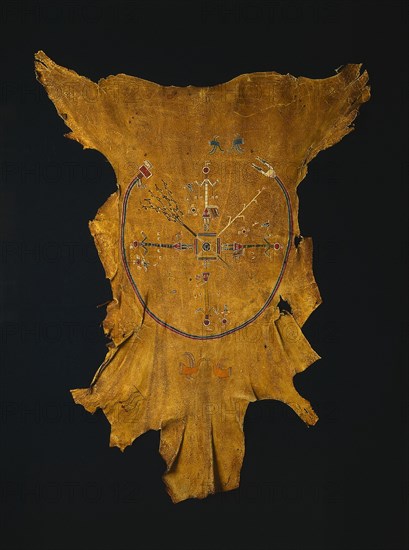
Sujet
Replica of a Drypainting (Iikaah) after a drypainting by Tsi-tcaci, late 1800s-early 1900s. Creator: Unknown.
Légende
Replica of a Drypainting (Iikaah) after a drypainting by Tsi-tcaci, late 1800s-early 1900s. This hide's imagery reproduces one of the drypaintings (sandpaintings) used during curing rituals by the Navajo of the American southwest. In Navajo thought, illness is caused by an imbalance in natural forces, which healing rites try to correct. To that end the drypaintings, created by pouring crushed pigments onto a sand-covered floor, often diagram an ordered, harmonious universe. Here four spiritual beings, perhaps patrons of the plants that sprout between them, radiate from a circular pool of water. By body colour and position, these beings describe phases of the sun's motion, placing them in balanced relation-the white of eastern dawn light appears across from yellow (the western sunset), and the black night sky (north) balances midday's blue (south). Encircling the group is a rainbow, which carries spiritual beings between this world and "the other side." Drypainting rites are performed during the last half of complex, eight-day healing ceremonies. After each painting is completed, its figures are brought to life with a blessing. Then the patient-called the "one-sung-over" because a singer (hataalii) chants much of the ceremony-sits on the painting and its pigments are applied to the ailing body. In this way, the one-sung-over is identified with the painting.
Crédit
Photo12/Heritage Images/Heritage Art
Notre référence
HRM19G21_010
Model release
NA
Property release
NA
Licence
Droits gérés
Format disponible
8,9Mo (1,3Mo) / 12,9cm x 17,3cm / 1523 x 2048 (300dpi)